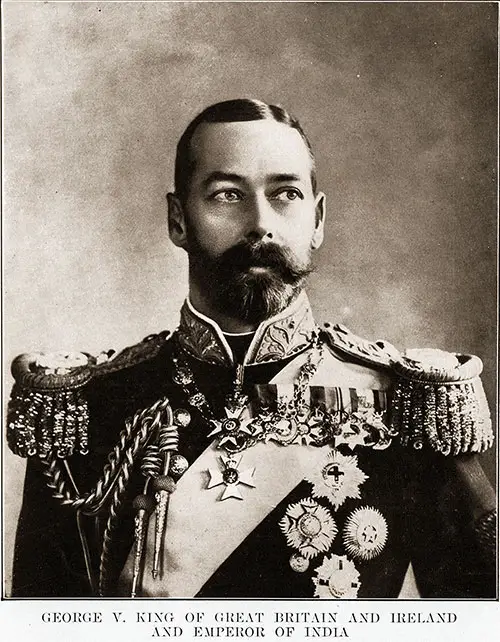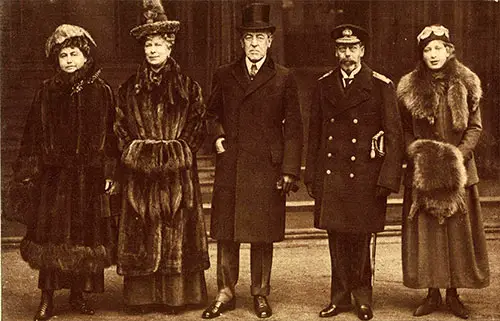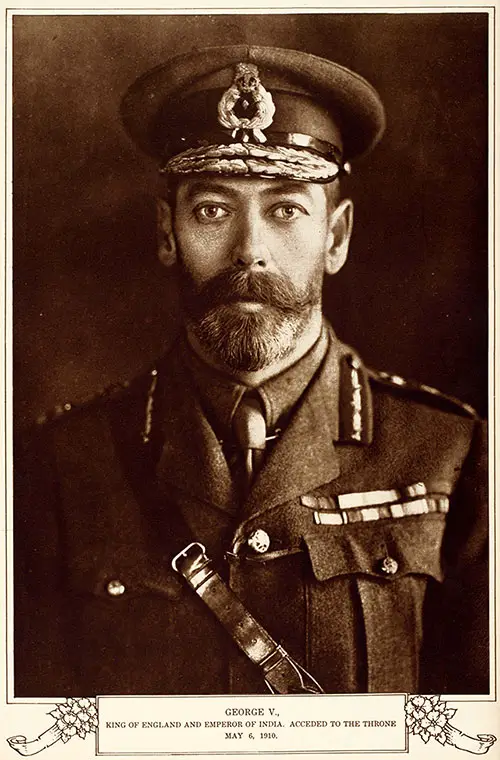George V of England Biography

Portrait Photograph of George V, King of Great Britain and Ireland, and Emperor of India. Collier's Photographic History of the European War, 1916. GGA Image ID # 18955f367d
The Most Popular Man in England—His Energetic Queen—The Royal Family in the War—The Prince of Wales
WHENEVER kings and queens make their appearance in public, the populace is expected to indulge in a becoming amount of demonstration, cheering and shouting, "God save the King!" and similar sentiments in the language of the country.
Unless a revolution is in progress, the people usually respond with as much sincerity as they can muster. But it is not hard to gauge a nation's affection for its sovereign when he is greeted by a spontaneous burst of genuine enthusiasm such as is described by a London paper in speaking of England's King:" 'Good old George!'
This may not at first blush appear to be a very respectful way of hailing one's sovereign, but it is the shout that rang out in Hyde Park when His Majesty reviewed the Legion that marches under the Silver Badge. Among Englishmen, the adjective 'old' when applied to a man indicates not age, but affection, that he is loved.
In this sense, it was applied to the King in Hyde Park, and none knew better than our sovereign how to take it. It told him, indeed, the depth of homely affection in which he is held. And it is betraying no royal confidence to say that it went straight to his heart." (The Literary Digest, 15 February 1919)
Early Life
George V, son of Edward VII and grandson of the adored Victoria, was born at Marlborough House, London, on 3 June 1865. He was brought up very simply, without much of King's intensive training- ship that one might expect.
The reason was, partly, because he was the younger of the two boys, with consequently a more remote chance of ruling, and somewhat because his father had been forced to spend his life in arduous preparation for the throne that he waited for so long. He was determined that his son should not be so burdened.
Edward, agreeing with an earlier king that "the best training for an English gentleman is aboard an English man-of-war," sent the two boys to Dartmouth to be trained for the Navy.
In 1879 they embarked on the Bacchante for a three-year voyage around the world, accompanied by their tutor, Canon Dalton. The young princes received no homage for their rank; in the democracy of the sea, they were known as "Sprat" and "Herring."
After this voyage, George was sent to the Continent for the customary princely tour to learn French and German. He became proficient in these languages but was never the accomplished linguist that his father was.
King George V continued his Navy career; in 1884, he was appointed sub-lieutenant on the ship Canada; and served subsequently on the Dreadnought and the Alexander. Before he was twenty-five, he had command of the Thrush.
The Queen

Great Welcome Extended to President in England. The President and Mrs. Wilson in Buckingham Palace, London, Photographed in Company of King George, Queen Mary and Their Daughter, Princess Mary Photograph © Central News Service. The War of the Nations, New York Times, 1919. GGA Image ID # 1961a9379e
Queen Mary seems to fit precisely the definition of a queen given by Bossuet, "Il n'y a rien que d'auguste dans sa personne, il n'y a rien que de pur dans sa vie."
This only daughter of the Duke and Duchess of Teck was born at Kensington Palace on 26 May 1867. She was christened, in the grand fashion of royalty, Victoria Mary Augusta Louisa Olga Pauline Clementine Agnes and known until her marriage, in 1893, as Princess May.
Her mother in a letter wrote of her: "She really is as sweet and engaging a child as you can wish to see, and playful as a kitten, with the deepest blue eyes imaginable, quantities of fair hair, a tiny rosebud mouth, a lovely complexion, and a most perfect figure. In a word, a model of a baby."
She was brought up very carefully by her mother, a person of great good sense, and taught many useful and domestic accomplishments. She darned her brothers' socks and became a skillful cook.

George V., King of England and Emperor of India. Acceded to the Throne May 6, 1910. The War of the Nations, New York Times, 1919. GGA Image ID # 1957556ffd
King George V of England He is a very poplar king and is said to be the busiest man in Europe.
When Princess May was sixteen, she was sent to Florence to learn Italian. She already knew French and German. Her education was carefully watched and included thorough religious training.
From childhood, she has had a lively interest in history, and her favorite authors are Macaulay, Froude, and Motley. She is fond, too, of fiction but considers the moderns a bit too advanced.
The Queen was always a favorite of Queen Victoria and was a prominent figure at court. Indeed, through her charities and various interests, she is well known and loved throughout the kingdom.
An Indefatigable Worker
Since the beginning of the war, the King's popularity has increased tenfold. When he ascended the throne in 1910, little was known of him, and indeed for some time after, the memory of his father overshadowed him.
But he soon showed the people that he was a ruler that could be trusted, and since the war, no one in all England has worked harder for the nation than the King.
"The barest recital of a fraction of what he has accomplished, accompanied often by Her Majesty, makes one marvel at the endurance and high sense of duty which could achieve this and much more.
His Majesty has carried out well over 200 inspections, reviewing in doing so over 2,000,000 troops; no division has left these shores for any of our seven fronts without either being inspected by the King or, if circumstances rendered that impossible, hearing a farewell message from him; he has visited with his sympathetic smile and kindly word the wounded in more than 300 hospitals; he has gone through 150 munition-factories, charming all, men, women, and girls, with his bonhomie, and has presented with his own hand more than 12,000 decorations won on the field of battle. Four separate visits have been paid to the Grand Fleet.
"The King is probably one of the busiest men in the Empire, his work being in many unthought-of and unheard-of labors. For this, Mr. Lloyd George vouched when he said, 'There is one man in England who is working as hard as the hardest-worked man in this country, and he is the sovereign of the realm." (The Literary Digest. 15 February 1919)
In his hours of ease, the King likes to shoot. He is one of the best wing shots globally, an expert navigator, an authority on men-o'- war, and domestic in his tastes. He hates classical music and likes energetic melodies, and he makes the collection of postage-stamps a hobby.
The Prince of Wales
This well-beloved Prince has been most democratically educated. He followed his father and went first to Osborn, then to Dartmouth for naval training, and later shipped as a middy on the Hindustan. At eighteen, he went to Oxford, where he was extremely popular, as he is wherever he goes.
When his country entered the war, he could not wait to join the Army. His commission had been given him, together with a lieutenancy in the Navy, on his eighteenth birthday, but Lord Kitchener was strongly opposed to his going to the front.
He had his way at last, however, and the letter of a private in the Coldstream Guards gives the general attitude toward him like a soldier: "I must tell you about the Prince, who is here with us. I can assure you he is as brave as a hero.
Only last night he passed me when German shells were coming over. You can take it from me that he is not only the Prince of Wales, but a soldier and a man, and we are all proud of him. He is not very big, but he has got a bigger heart than a lot who are hanging back in Great Britain.'
In the summer and autumn of 1919, the Prince of Wales visited Canada and the United States, thus repeating the famous experience of his grandfather, Edward VII, who, in his youth, came to America as Prince of Wales; and his unaffected simplicity won him a host of friends.
"George V of England: The Most Popular Man in England—His Energetic Queen—The Royal Family in the War—The Prince of Wales," in Harper's Pictorial Library of the World War, Volume IX: War Makers and Peace Makes: Character Studies of the Leading Actors in the Conflict, New York-London: Harper & Brothers Publishers, 1920, pp. 392-395.
